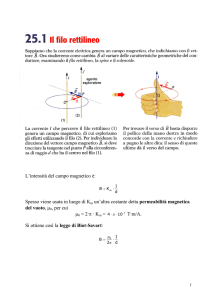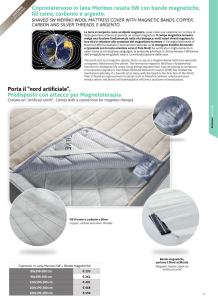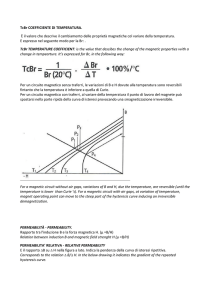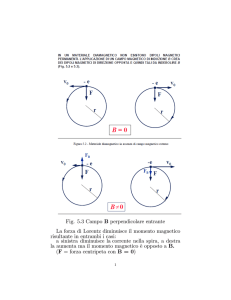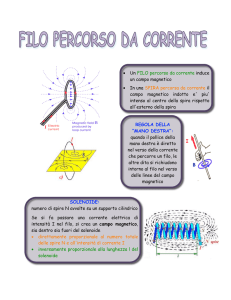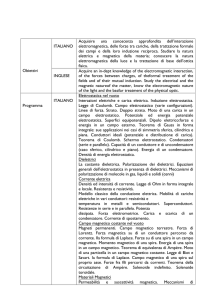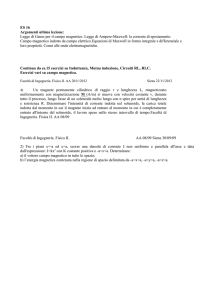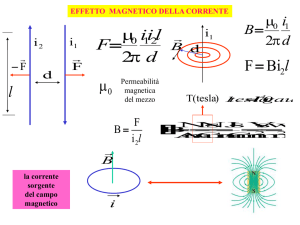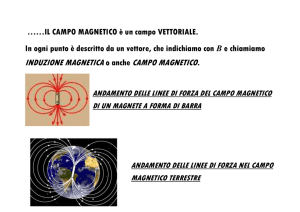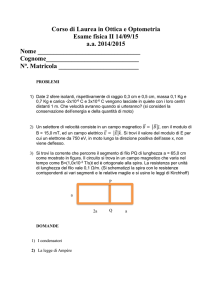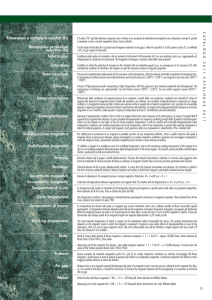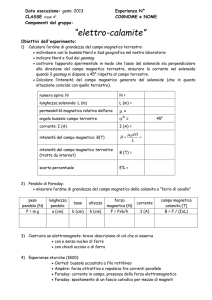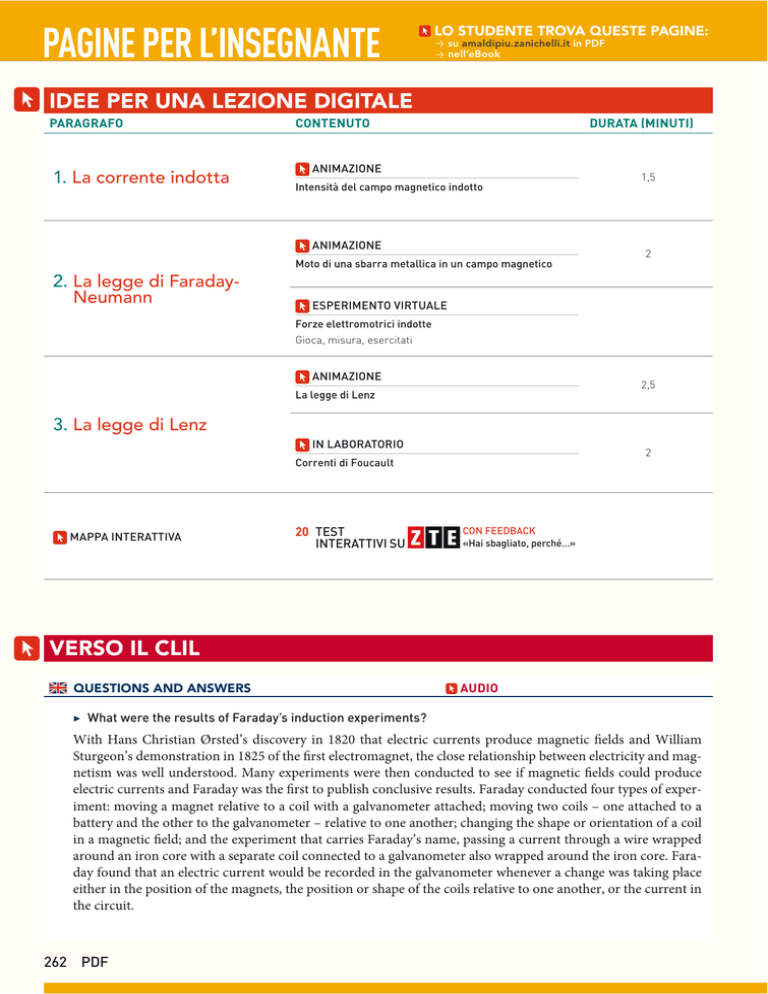
PAGINE PER L’INSEGNANTE
LO STUDENTE TROVA QUESTE PAGINE:
p su amaldipiu.zanichelli.it in PDF
p nell’eBook
IDEE PER UNA LEZIONE DIGITALE
PARAGRAFO
1. La corrente indotta
CONTENUTO
DURATA (MINUTI)
ANIMAZIONE
Intensità del campo magnetico indotto
ANIMAZIONE
Moto di una sbarra metallica in un campo magnetico
2. La legge di FaradayNeumann
1,5
2
ESPERIMENTO VIRTUALE
Forze elettromotrici indotte
Gioca, misura, esercitati
ANIMAZIONE
2,5
La legge di Lenz
3. La legge di Lenz
IN LABORATORIO
2
Correnti di Foucault
MAPPA INTERATTIVA
20 TEST
INTERATTIVI SU
CON FEEDBACK
«Hai sbagliato, perché…»
VERSO IL CLIL
QUESTIONS AND ANSWERS
AUDIO
▶ What were the results of Faraday’s induction experiments?
With Hans Christian Ørsted’s discovery in 1820 that electric currents produce magnetic fields and William
Sturgeon’s demonstration in 1825 of the first electromagnet, the close relationship between electricity and magnetism was well understood. Many experiments were then conducted to see if magnetic fields could produce
electric currents and Faraday was the first to publish conclusive results. Faraday conducted four types of experiment: moving a magnet relative to a coil with a galvanometer attached; moving two coils – one attached to a
battery and the other to the galvanometer – relative to one another; changing the shape or orientation of a coil
in a magnetic field; and the experiment that carries Faraday’s name, passing a current through a wire wrapped
around an iron core with a separate coil connected to a galvanometer also wrapped around the iron core. Faraday found that an electric current would be recorded in the galvanometer whenever a change was taking place
either in the position of the magnets, the position or shape of the coils relative to one another, or the current in
the circuit.
262 PDF
INDUZIONE E ONDE ELETTROMAGNETICHE
38 L’INDUZIONE ELETTROMAGNETICA
▶ State Faraday’s Law of induction and show the ways in which an electric current can be induced.
Faraday’s law states that the induced electromotive force (EMF) in any closed circuit is equal to the negative of
the time rate of change of the magnetic flux through the circuit. When a loop of wire forms part of the circuit,
the magnetic flux of a magnetic field B through the surface A associated with the coil is given by the vector dot
product B · A = BAcos(θ). An EMF is therefore induced and a current flows in the circuit when: the magnitude
of the magnetic field changes with time; the area enclosed by the loop changes with time; the angle between the
magnetic field and the normal to the surface changes with time; or any combination of these conditions. (Although this law was first stated quantitatively by the German physicist Franz Neumann, it is rarely also attributed to Neumann in English speaking countries.)
▶ State Lenz’s law and explain how it can be used to find the direction of induced currents.
Lenz’s law can be stated in two ways: the induced current produces magnetic fields that tend to oppose the
change in magnetic flux that induces the current; or, an induced EMF is always in the direction that opposes the
change in flux that gave rise to the EMF. When the north pole of a magnet approaches a coil, the magnetic field
induced in the coil can be thought of as an opposing magnet with north pole in the direction of the north pole
of the approaching magnet. The direction of the current in the coil is given by the right hand grip rule with the
thumb pointing in the direction of the approaching magnet. If the magnet inducing the current changes direction and moves away from the coil, the coil acts as an attracting magnet with south pole pointing towards the
departing magnet and the induced current flows in the opposite direction.
▶ What is motional EMF?
A source of electrical potential created in a stationary conductor by a changing magnetic field is an induced
EMF. A conductor moving in a constant magnetic field leads to an induced EMF that is referred to as motional EMF. For instance, the charges in a conducting rod moving with velocity v in a constant magnetic field B
experience a magnetic force qv # B which causes the positive charges in the rod to move in one direction and
the negative charges in the opposite direction. The resultant build up of charge leads to a polarisation in the rod
and a potential difference between its ends. The associated electric field produces a force qE on the charges in
opposition to the magnetic force qv # B . The accumulation of charges at the ends of the rod continues until the
forces balance (E = vB) when the potential difference between the top and bottom of the rod is E, = vB,. The
moving polarised rod is a source of electrical potential and if connected to a circuit would establish a current in
the circuit.
▶ What is the orientation of the Earth’s magnetic field?
The Earth’s magnetic field is due to electric currents caused by the motion of molten iron alloys in the Earth’s
outer core. We can trace the magnetic field lines using a simple compass. The north pole of a compass, in the
absence of any strong local magnetic fields such as from a bar magnet, will always point north – it was originally
called the north-seeking pole, then shortened to north pole for simplicity. However, we know that the north
pole of one magnet must be attracted by the south pole of another. The compass needle is actually indicating the
south pole of Earth’s magnetic field. This can be seen by inspecting a diagram of the Earth’s magnetic field: the
field lines exit near the geographical South Pole and enter near the geographical North Pole.
263 PDF
PAGINE PER L’INSEGNANTE
LO STUDENTE TROVA QUESTE PAGINE:
p su amaldipiu.zanichelli.it in PDF
p nell’eBook
PROBLEMI MODELLO, DOMANDE E PROBLEMI IN PIÙ
1
5
★★★
2
18
★★★
LA CORRENTE INDOTTA
L’area di ognuna delle spire che formano una bobina è
pari a 2.0 cm2. La bobina è percorsa da una corrente che
genera al suo interno un campo magnetico di 0,25 T. Il
flusso del campo attraverso la bobina è di 1,0 Wb.
▶ Calcola il numero di spire della bobina.
[2,0 × 104]
LA LEGGE DI FARADAY-NEUMANN
Il circuito mostrato nella figura è immerso in un campo
B = 1,1 T omogeneo, costante e perpendicolare al circuito, con verso entrante nel foglio. La sbarretta conduttrice
AB che chiude il circuito, inizialmente in quiete, di massa m = 0,10 kg e lunga l = 1,0 m, è libera di scivolare senza attrito sotto l’azione del proprio peso. La capacità del
condensatore è C = 0,80 F. Trascura le resistenze e l’attrito dell’aria.
▶ Calcola l’accelerazione con cui cade la sbarretta.
C
A
B
[0,92 m/s2]
4
29
★★★
L’AUTOINDUZIONE E LA MUTUA INDUZIONE
Un circuito in cui il flusso di un campo magnetico
vale 8,0 × 10−5 Wb è percorso da una corrente di intensità 8,0 × 10−1 A.
▶ Quanto vale l’induttanza del circuito?
30
★★★
[1,0 × 10−4 H]
5
41
★★★
Un circuito ha un coefficiente di autoinduzione di 5,5 × 10−1 H. L’intensità della corrente passa
da 0 a 5,0 × 10−1 A in 4,0 s.
▶ Calcola la forza elettromotrice media indotta nel circuito.
[−69 mV]
ENERGIA E DENSITÀ DI ENERGIA DEL CAMPO MAGNETICO
L’avvolgimento di un solenoide è fatto con un filo che
ha una resistenza di 36 Ω. Il solenoide ha un’induttanza
di 5,4 mH. Ai capi dell’avvolgimento c’è una differenza
di potenziale di 5,1 V.
▶ Calcola l’energia immagazzinata nel campo magnetico del solenoide.
[5,4 × 10−5 J]
264 PDF
42
★★★
Un solenoide, che contiene 200 spire ognuna di raggio 2,00 cm, ha un’induttanza che vale 6,31 × 10−4 H ed è
attraversato da una corrente di intensità pari a 300 mA.
▶ Calcola la lunghezza del solenoide.
▶ Calcola la densità di energia del campo magnetico del
solenoide.
[10,0 cm; 226 mJ/m3]
38 L’INDUZIONE ELETTROMAGNETICA
INDUZIONE E ONDE ELETTROMAGNETICHE
PROBLEMI GENERALI
8
★★★
Un solenoide di 500 spire è concatenato ad un flusso di
induzione magnetica di 1,2 × 10−4 weber. Riducendo il
flusso a 3 × 10−5 weber in 0,015 secondi, calcolare la f.e.m.
media indotta.
Il campo è uscente dalla pagina. Supponi che i conduttori
abbiano resistenza nulla. In queste condizioni si genera
nel circuito, chiuso dal conduttore mobile, una corrente
indotta che tende a rallentare la caduta di quest’ultimo.
Determina:
▶ il verso della corrente indotta.
(Esame di Fisica, Corso di laurea in Scienze biologiche, Università di
Genova, 2003/2004)
[3 V]
9
★★★
[10,89 A]
10
zione della resistenza elettrica.
Una spira conduttrice circolare di raggio 20 cm e di resistenza elettrica pari a 3 ohm è perpendicolare ad un campo magnetico che aumenta da zero a 1,3 T in 0,005 secondi. Trovare il valore medio della corrente indotta.
(Esame di Fisica, Corso di laurea in Scienze biologiche, Università di
Genova, 2003/2004)
★★★
▶ la velocità massima di caduta e come essa varia in fun(Elaborato dagli esami di maturità nei licei scientifici sperimentali, 1988)
[61 m/s]
12
★★★
Una spira circolare di raggio 5,0 cm ha una resistenza pari a 4,0 × 10−3 Ω. Un campo magnetico è disposto
perpendicolarmente ad essa e ha un’intensità variabile nel tempo. La variazione di flusso del campo magnetico avviene in 2,0 s e produce nella spira una corrente
di 0,50 A. Calcola:
▶ il valore della forza elettromotrice media indotta;
▶ la variazione di flusso;
▶ la corrispondente variazione del campo magnetico
esterno.
[2,0 × 10−3 V; 4,0 × 10−3 Wb: 0,51 T]
11
★★★
Per effetto del proprio peso, un conduttore di lunghezza 1 m e massa 0,1 kg scivola in caduta, senza attriti di
nessun tipo e partendo da fermo, lungo due guide conduttrici verticali che sono collegate in alto da una resistenza elettrica R = 10 Ω. Un campo magnetico uniforme
di intensità 0,4 T è perpendicolare al piano del circuito.
La situazione è rappresentata nella figura:
Una grande spira rettangolare ABCD di lati
AB = a = 2,0 m e CD = b = 1,0 m, massa m = 1,0 kg e resistenza R = 10 Ω si muove con una velocità v0 (diretta
come AB) lungo un piano orizzontale privo d’attrito. A
un certo istante incontra una zona dove è presente un
campo magnetico uniforme, costante e perpendicolare al
piano orizzontale. Trascurando fenomeni di autoinduzione, troviamo che la velocità della spira ha subito una
variazione Δv = −10 m/s quando è penetrata nel campo
per una lunghezza pari a a/2.
▶ Determina l’intensità del campo magnetico B.
[10 T]
13
★★★
CON GLI INTEGRALI Per la spira dell’esercizio prece-
dente è possibile ricavare la velocità istantanea risolvendo l’equazione differenziale che si ottiene dalla seconda
legge della dinamica.
▶ Calcola la velocità dopo 0,10 s dall’ingresso nella regione di campo magnetico uniforme, nel caso in cui
B = 10 T e v 0 = 32 m/s .
[12 m/s]
R
B
265 PDF

